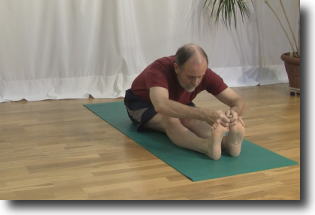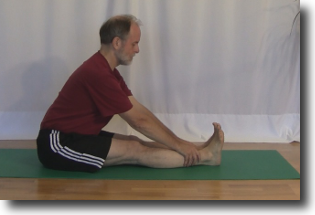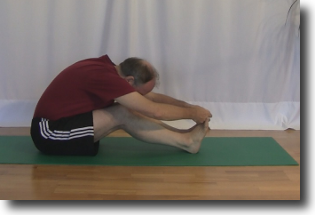Bob is struggling to reach his feet in Pashimottasana. Bob’s head has almost disappeared into his shoulders. He has lifted his shoulder blades a long way up towards his ears in his attempt to reach his feet with his hands. He looks an awful lot like a turtle.
Later Bob is complaining about how sore his neck and upper back are.
There are a couple of things that Bob can do to avoid the turtle effect and enjoy Pashimottasana more.
What is Pashimottasana
Pashimottasana is the sanskrit name for a basic forward fold. Pashimottasana means intense stretch of the west. Traditionally your yoga practice is done in the morning facing the rising sun. When you fold forward you are stretching your back muscles that are facing westward, hence the name Intense stetch of the west.
This is the first posture of the Primary series of Ashtanga Yoga. It is a basic seated forward fold. There is no binding of the arms, and no twisting of the torso.
How to do the pose
You start in Dandasana, siting on the floor with your legs straight out in front of you and the back of your hips and torso rising straight up from the floor.
From here you engage Uddiyana Bandha (your lower abdominal muscles) and as you exhale, bring the top of your hips forward, your arms forward towards your feet and lower your torso towards your thighs.
Bring your gaze towards your toes and hold this position for several breaths.
There are three variations of this posture and they all involve the position of your hands relative to the feet.
- Variation A – Hold the big toes with the first two fingers with your palms facing each other.
- Variation B – Hold the little toe side of the feet. Your thumbs are across the toes and your fingers are on the soles of your feet.
- Variation C – Reach beyond your feet and interlace your fingers together with your palms facing towards you.
Each of the variations from A to C require more and more flexibility in your hamstrings and your hips.
As you can see this is a very easy pose to do. However you can injure your neck muscles in this pose if you are not careful.
How can you injure neck in Pashimottasana
You can injure your neck muscles when you bring your arms forward towards your feet. Trying to move your arms and hands into each of the three variations above requires more and more flexibility.
Attempting to reach and hold your feet before your body is ready will result in your shoulder blades rising up towards your ears. This will result in the turtle effect.
This lifting of the shoulder blades will result in stress and tension building up in your neck and upper back muscles. Too much of this stress and tension can result in injury to your neck and upper back muscles.
Why do you injure your neck
There are a few reasons why you injure your neck in this pose.
1. Your Ego
You see your teacher and several people around you doing the pose and holding their feet. You feel compelled to do the pose as well as them.
Your ego is pushing you to keep up. You do not want to be left behind. You want to be seen as good as everyone else is.
Your ego pushes you to ignore the limitations of your body and pull yourself into the pose.
2. You ignore feedback from the body
The second thing that happens is that you ignore what your body is telling you. Your hamstrings and hips are telling you that you can not go any further into the pose.
In your desire to do the pose to the same extent as your teacher, you ignore this feedback and you reach forward with your hands and grab your feet. To compound matters even further, you ignore the feedback from your body once again as you lift your shoulder blades up towards your ears in order to grab your feet.
There are a few things that you can do to avoid injuring your neck.
How to avoid the Turtle Effect
There are two things you can do in this pose to protect your neck and upper back and avoid the turtle effect.
1. Accept where you are at
One of the most difficult thing for a person new to yoga to learn is accepting the limitations that their body is placing on them when they attempt to do a pose. Their current flexibility will limit how well they can do a particular pose. Learning to accept this limitation and work within the limits that their flexibility has placed on them is a very important lesson that yoga is teaching them.
Unfortunately it takes about six months for a person new to yoga to learn this lesson and accept where they are at in a particular pose. Once this lesson is learnt, their yoga practice will become much more satisfying.
2. Modify the pose
Once you have learnt to accept the limitations of your body’s ability to do a pose then you need to learn the appropriate modifications to the pose. These modifications work with your body’s current flexibility while protecting you from injuring yourself.
Rather than grabbing the feet in Pashimottasana and injuring your neck and upper back, you should reach forward and hold the shins. Pay attention to the feedback from your neck and shoulders as you move your hands forward along your shins. When you feel your shoulder blades start to lift and the tension building in your neck muscles it is time to back off a little bit and hold your hands in position on your shins.
But I want to hold my feet like everyone else
There is a modification that you can do that will permit you to hold your feet without injuring your neck and upper back.
As you fold forward into Pashimottasana bend your knees and bring your feet slightly closer to your hips. Keep bending your knees until you can comfortable hold on to your feet.
Once you are holding your feet, you can start to very slowly straighten out your legs. It is very important at this point to pay close attention to the feedback from your body and in particular your neck and upper back muscles. You want to comfortably challenge your body in the pose, but you do not want to cause injury. Just go as far into the pose as you feel comfortable.
Summary
Pashimottasana is a very simple pose to do. Your legs are out in front and your lower your torso towards your legs and grab your feet. However you can injure your neck and upper back if you try to go beyond the flexibility limits of your body.
There are some things that you can do in the pose to avoid injuring your neck and upper back:
- Learn to accept the limits that your body places on you in a yoga pose. This is an important lesson that your yoga practice is teaching you. It takes a lot of time to learn this lesson.
- Pay attention to the feedback form the body and work within the limitations of your body.
- Modify the pose to work within the flexibility of your body.
Honor the feedback from your body and accept where you at in the pose. And like a turtle that is relaxed, keep your head and neck extended out of your shell.
Next steps
Work with your teacher to make sure that you are not injuring your neck and upper back muscles in Pashimottasana.
Additional readings
To learn mores ways to avoid injuring yourself in Pashimottasana read 3 ways to protect your Hamstrings in Pashimottasana.
Read How to avoid yoga injuries: follow these 5 great guidelines to learn more about avoiding injury.
Protect your lower back by following the tips in this article How to avoid the bow and protect your lower back in Pashimottanasana.








Thank you for this article. Keep them coming, love it!!!